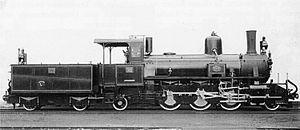BHStB IIIb5
| BHStB / BHLB / SHS IIIb5 JDŽ / JŽ 73 |
|
|---|---|
| Number: | 23 |
| Manufacturer: | Krauss Linz , MÁVAG |
| Year of construction (s): | 1907-1913 |
| Type : | 1'C1'h2 |
| Gauge : | 760 mm ( Bosnian gauge ) |
| Length over coupling: | 13.129 m |
| Total wheelbase: | 11,150 m |
| Service mass: | 30.6 t |
| Friction mass: | 20.6 t |
| Top speed: | 55 km / h |
| Indexed performance : | 360 hp |
| Starting tractive effort: | 40 kN |
| Coupling wheel diameter: | 1100 mm |
| Impeller diameter: | 640 mm (rear) |
| Cylinder diameter: | 370 mm |
| Piston stroke: | 450 mm |
| Boiler overpressure: | 12 atü |
| Grate area: | 1.54 m² |
| Evaporation heating surface: | 91.95 m² |
| Tender: | Tender |
| Water supply: | 5.5 m³ |
| Fuel supply: | 3 t |
The series IIIb5 were steam locomotives with three coupled axles and two-axle Tender in Bosnian gauge , procured from 1907 to 1913 by the Herzegovinian Bosnian-State Railways (BHStB). The Yugoslav Railways (JDŽ, later JŽ) referred to it as the 73 series.
history
In the first few years of the 20th century, technical progress overtook the complicated Klose construction used in the IIIa4 and IIa4 series . The development of the Krauss-Helmholtz steering frame in connection with laterally displaceable coupling axles made it possible to build steam locomotives that were coupled several times, but still curved well. Krauss in Linz designed the 1907 Tender locomotives of the series IIIb5 with Schmidt superheater after which series Mh as superheated steam locomotive in the Lower Austrian State Railways had worked well. Because of the joint administration by the Austrian and Hungarian halves of Bosnia-Herzegovina, 15 machines came from Krauss' Linz plant and the other 8 from the Budapest machine factory (MÁVAG).
technical features
The prairie locomotives with an outer frame and a wide fire box have a Krauss-Helmholtz frame at the front and rear. The drive takes place on the coupling axle, which is loose in the middle of the flange . The IIIb5 series, like the older Klose machines, does not have a fixed wheelbase, but has a large guided length. With this chassis, the locomotive is suitable for radii of up to 50 meters. The drive takes place via Hall cranks , the control according to the Heusinger system . The cylinders are equipped with piston valves. With the largest drive wheel diameter on the Bosnian-Herzegovinian State Railways of 1,100 millimeters, the express tractor reached a speed of 60 km / h, which was remarkable for the time with a standard speed of 35 km / h. The locomotives are equipped with the Gresham type vacuum brake and a handbrake . The individual locomotives differed in the arrangement of the sandboxes , some machines were equipped with a Kobel spark arrester .
business
The locomotives proved their worth and were preferred on the Bosna Railway between Sarajevo and Bosanski Brod . In the Yugoslav Railways (JDŽ, later JŽ) they were designated as series 73. When the Bosna Railway was replaced by the standard gauge line Sarajevo – Šamac in 1947 , the machines were increasingly used on other lines. In 1965 there were still 22 machines, 5 of which were assigned to the Belgrade Directorate and 17 to the Sarajevo Directorate. On the valley section of the Narentabahn between Konjic and the Adriatic Sea and on the former Steinbeisbahn , they were in use until the 1970s.
Train on the Bosnabahn with a JDŽ 73 and a reversing JDŽ 189 as a leader locomotive
Steinbeisbahn train in Prijedor with JŽ 73-008 ready to leave
JŽ 73-015 in front of the boiler house in Prijedor in August 1967
Three locomotives have been preserved:
The JŽ 73-002 is exhibited in the Požega Railway Museum in Serbia.
The JDŽ 73-018 stands on the abutment of the bridge over the Neretva in Jablanica , Bosnia and Herzegovina, which was blown up in 1943 .
The 73-019 of Club 760 runs on museum trains on the Pinzgauer local railway in Austria.
Locomotive list
| Construction year | Manufacturer | BHStB no. | BHLB no. from 1908 |
SHS no. from 1918 |
JDŽ no. from 1933 |
Remarks |
|---|---|---|---|---|---|---|
| 1907 | Krauss Linz | 151-153 | 151-153 | 151-153 | 73-001-003 | 73-002: Museum Požega |
| 1908 | 154-162 | 154-162 | 154-162 | 73-004-012 | ||
| 1911 | 163-165 | 163-165 | 163-165 | 73-013-015 | ||
| MÁVAG | 166-167 | 166-167 | 166-167 | 73-016-017 | ||
| 1913 | 168-173 | 168-173 | 168-173 | 73-018-023 | 73-018: set up in Jablanica 73-019: Club 760 , Zell am See |
swell
- Herbert Ortner: The 73 series of the Yugoslav State Railways. In: “The Narrow Track” www.schmalspur-europa.at, October 2008
- Data sheet 73-019 Steam locomotive of the Pinzgauer local railway. Pinzgauer Lokalbahn , June 2015
- Karl Tindl: Section reports . Specialist group of machine engineers. Report on the meeting of January 31, 1911 with a lecture by Mr. Steffan about the development of locomotive types on the lines of the Bosnian-Herzegovinian state railways. In: Journal of the Austrian Association of Engineers and Architects. Year 1911, issue 22, pages 348–350 (digitized version 1865–1917 at TU Cottbus; PDF; 51.2 MB)
- Josef Pospichal: Locomotive statistics. JDŽ 73. Retrieved October 15, 2017 .
Remarks
- ^ Bosnian-Herzegovinian state railways








